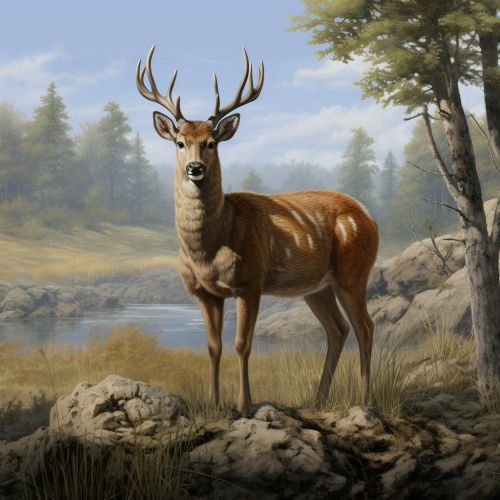Protylopus
Taxonomy and Evolution
The Protylopus is an extinct genus of the family Camelidae, which includes modern day camels and llamas. The genus is considered to be the earliest known camel, having lived during the Eocene epoch approximately 40 to 46 million years ago. The name Protylopus is derived from Greek words, meaning "first sheath", which refers to the sheath-like covering of the upper incisors, a characteristic feature of this genus.
The family Camelidae, to which Protylopus belongs, is part of the order Artiodactyls, a group of even-toed ungulates. This order also includes other well-known families such as the Cervidae (deer), Bovidae (cattle, goats, sheep), and Suidae (pigs). The Artiodactyls are characterized by their even number of toes, usually two or four, and their complex stomachs adapted for fermenting plant material.


Description
Protylopus was a small, deer-like animal, standing about 60 centimeters (2 feet) at the shoulder. It had a slender, elongated body and a relatively short tail. The head was small with large, round eyes, and the ears were long and pointed. The legs were long and slender, ending in small, narrow hooves. Unlike modern camels, Protylopus did not have humps.
The dentition of Protylopus was similar to that of modern camels, but with some notable differences. The upper incisors were covered by a sheath, a feature that gave the genus its name. The molars were low-crowned and had a simple pattern of cusps, indicating a diet of soft leaves and fruits.
Habitat and Distribution
Fossils of Protylopus have been found in North America, specifically in the Eocene deposits of the Wind River Basin in Wyoming. This suggests that the genus was native to this region. During the Eocene, the climate of North America was warm and humid, with lush forests covering much of the continent. This would have provided an ideal habitat for Protylopus, which was likely a forest-dwelling animal.
Diet
As a member of the Camelidae family, Protylopus was likely a herbivore. The structure of its teeth suggests that it fed on soft vegetation, such as leaves and fruits. The low-crowned molars would have been well-suited for grinding up this type of food. However, the exact details of its diet are not known, as direct evidence, such as stomach contents or coprolites, has not been found.
Behavior and Lifestyle
The behavior and lifestyle of Protylopus are not well known, as they can only be inferred from the available fossil evidence. However, based on its physical characteristics and the environment in which it lived, some assumptions can be made. Its small size and slender body suggest that it was a fast and agile animal, capable of running quickly to escape predators. The large eyes may indicate that it was active during the night or twilight (crepuscular), when good vision would be advantageous.
Extinction
The exact cause of the extinction of Protylopus is not known. However, it is likely that changes in the environment, such as the gradual drying and cooling of the climate during the late Eocene, played a role. These changes would have led to a reduction in the forest habitats that Protylopus depended on, making survival more difficult. The genus was eventually replaced by other, more advanced camels, which were better adapted to the changing conditions.
